
The Balkans, also known as the Balkan Peninsula, is a geographic area in Southeast Europe with various geographical and historical definitions. The region takes its name from the Balkan Mountains that stretch throughout the whole of Bulgaria. The Balkan Peninsula is bordered by the Adriatic Sea in the northwest, the Ionian Sea in the southwest, the Aegean Sea in the south, the Turkish Straits in the east, and the Black Sea in the northeast. The northern border of the peninsula is variously defined. The highest point of the Balkans is Mount Musala, 2,925 metres (9,596 ft), in the Rila mountain range, Bulgaria.
This article includes information on the demographic history of Kosovo.
Southeast Europe or Southeastern Europe (SEE) is a geographical subregion of Europe, consisting primarily of the Balkans. Sovereign states and territories that are included in the region are, in alphabetical order: Albania, Bosnia and Herzegovina, Bulgaria, Croatia, Cyprus, Greece, Kosovo, Montenegro, North Macedonia, Romania, Serbia, and Turkey. Sometimes, Moldova and Slovenia are also included. The largest city of the region is Istanbul, followed by Bucharest, Sofia, Belgrade, and Athens.
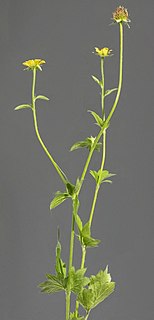
Geum urbanum, also known as wood avens, herb Bennet, colewort and St. Benedict's herb, is a perennial plant in the rose family (Rosaceae), which grows in shady places in the temperate regions of Eurasia. It has been introduced in North America, where it forms natural hybrids with Geum canadense.

Geum rivale, the water avens, is a flowering plant in the genus Geum within the family Rosaceae. Other names for the plant are nodding avens, drooping avens, cure-all, water flower and Indian chocolate. It is native to the temperate regions of Europe, Central Asia and parts of North America, where it is known as purple avens. It grows in bogs and damp meadows, and produces nodding red flowers from May to September.

The Accursed Mountains also known as the Albanian Alps are a mountain group in the western part of the Balkans. It is the southernmost subrange of the 1,000-kilometre-long (621 mi) Dinaric Alps range (Dinarides), extending from northern Albania to south Kosovo and northeastern Montenegro. Maja Jezercë standing at 2,694 m (8,839 ft) is the highest point of the Accursed Mountains and of all Dinaric Alps, and the fifth highest peak in Albania. The highest peak in Montenegro, Zla Kolata at 2,534 m (8,314 ft) and the second-highest in Kosovo, Gjeravica at 2,656 m (8,714 ft) are also part of the range.
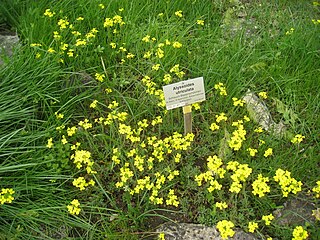
Alyssoides is a genus of flowering plants in the family Brassicaceae containing a single species, Alyssoides utriculata. A herbaceous perennial plant native to Southern Europe and Turkey, it grows on dry rocky slopes and on calcareous rocks, reaching heights of 20 to 50 cm and blooming with yellow flowers between April and May–July.

Geum bulgaricum is a species of flowering plant of the genus Geum (avens) in the family Rosaceae. A perennial herbaceous plant, it has small, bell-like yellow flowers, and is native to a few mountains on the Balkan Peninsula.
Serbia was one of the main parties in the Balkan Wars, victorious in both phases. It gained significant territorial areas of the Central Balkans and almost doubled its territory. During the First Balkan War, most of the Kosovo Vilayet was taken by Serbia, while the region of Metohija was taken by the Kingdom of Montenegro, its main allies. Over the centuries, populations of ethnic Serbs and Albanians tended to shift following territorial handovers. As a result of the multi-ethnic composition of Kosovo, the new administration provoked a mixed response from the local population. Whilst according to Noel Malcolm the Albanians did not welcome Serbian rule, the non-Albanian population in the Kosovo Vilayet considered this a liberation. Kosovo Vilayet was internationally recognised as a part of Serbia and northern Metohija as a part of Montenegro at the Treaty of London in May 1913. In 1918, Serbia transformed into the newly Kingdom of Serbs, Croats and Slovenes, later named Yugoslavia. Disagreements regarding the territory of Macedonia among the members of the Balkan League led to the Second Balkan War. Here, Serbia and Greece fought against Bulgaria in 1913. Finalisations concerning which country took which parts were ratified at the Treaty of Bucharest the same year. Serbia came to control the land which became known as Vardar Macedonia, which today stands independent as North Macedonia.

Geum montanum, the Alpine avens, is a species of flowering plant of the genus Geum in the Rosaceae family, native to the mountains of central and southern Europe.

Kosovo is characterised by a diverse biodiversity and an abundance of different ecosystems and habitats determined by the climate along with the geology and hydrology. Predominantly mountainous, it is located at the center of the Balkan Peninsula bounded by Montenegro to the west, Serbia to the north and east, North Macedonia to the southeast, and Albania to the southwest.
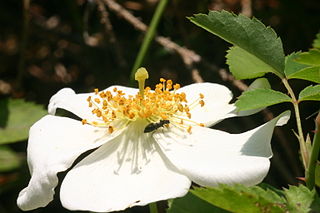
Rosa arvensis, the field rose, is a species of wild rose native to Western, Central and Southern Europe.

Rosa tomentosa, otherwise known as the harsh downy-rose, is a species of wild rose. It is a shrub growing to about 3 metres (10 ft). It is found in Asia Minor, the Caucasus, and much of Europe: the British Isles, France, Central Europe, northern Spain, Italy, and the Balkans . On the British Isles it can be found in hedgerows and woodland margins, and it typically flowers between June and July. Further south, in Bulgaria, it flowers in May.
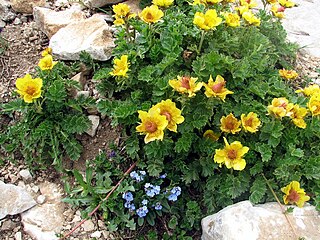
Geum reptans, the creeping avens, is a species of flowering plant in the genus Geum of the family Rosaceae native to some mountains of Central and Southeastern Europe. A long-lived perennial that reproduces both sexually and clonally, it has high phenotypic variation, but these variable traits do not appear to be adaptations to local conditions.
Rosa oxyodon is a species of wild rose native to the Caucasus. It is closely related to Rosa pendulina.
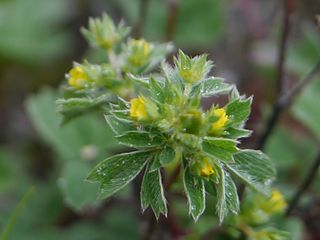
Sibbaldia parviflora is a species of flowering plant in the genus Sibbaldia of the family Rosaceae, native to Southeast Europe and West Asia. It is a herbaceous perennial plant growing in damp rocky places on alpine meadows.
Geum molle is a species of flowering plant of the genus Geum (avens) in the family Rosaceae. A perennial herbaceous plant found on meadows, it is native to the mountains of the Balkan Peninsula and Italy. It blooms with yellow flowers between June and August.
Geum borisii may refer to the following plants of the genus Geum:
Alyssum pulvinare is a species of flowering plant in the genus Alyssum (madwort) of the family Brassicaceae. A perennial herbaceous plant native to the Balkans, it grows on rocky places, rock ledges and dry grassy slopes, forming tufts about 6–15 cm high. It flowers in May and June.












